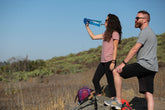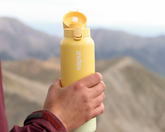Making sure that there’s enough water is one of the basic tenets of hiking in the wilderness. The same goes for camping, where simply putting a crate of bottled water into the boot seems like a one-stop solution for a drinking water supply on hand.
I can confess to having made both of these mistakes, when I was a beginner. But after all the walkabouts and camping tours I have under my belt now, I can safely say that I am firmly in the church of reusable bottles.
The Devil in the single-use plastic details
Plastic bottles may be light and weigh next to nothing when empty, but they are one of the worst ways to carry your water supply.
For starters, you can’t refill them without putting yourself at risk of ingesting plastic fibers, microplastic particles, and chemical solvents. I had previously thought that I could use single-use plastic bottles a couple of times throughout a hike and then toss them out. But even this was a bad decision, which I hurried to rectify.
Single-use plastic bottles that have Bisphenol A or BPA in their structure are directly linked to hormonal irregularities in humans..
And if you think that you’ll simply use each bottle only once, you should know: a study by the WHO has shown that over 90% of bottled water contains plastic fibers in it. Once I read up on that, the idea of using single use plastic bottles was totally abhorrent to me.
You can’t get away with ‘oh, maybe a couple of reuses won’t hurt me’ either. Repeated refilling ‘dissolves’ the wall of the plastic bottle, because they’re not made for multiple uses, and you end up drinking that. Plus, cracks in the bottles are breeding grounds for bacteria. The idea of drinking from these germ pools when camped out far away from a city was too much for me.
Simply put, single-use plastic is one the most unsafe ways to carry water, whether going camping or biking cross country. But the alternatives I’ve found have solved this issue.
Clean is green
First and foremost, you need to know if there is a water source on site. Many trails I’ve hiked have water stations close to the main path, where I could simply refill my water container.
Others, like camping sites near water bodies, had water in the vicinity. I always made sure to thoroughly check the area I was going to cover beforehand, so these could be planned into the route. And then, I made sure to have my best adventure buddy with me- my water purifier.
Depending on your requirements, you can get a water filter or purifier, but both will guarantee you clean water. A simple combination of water purifier and refillable bottle takes care of your water’s potability and your water supplies.
I always take both my bottle filter and my UV light purifier with me. They have a minimal weight and take care of everything from sediment to bacteria, virii, and parasites in the water. (You can look up what kind suits you here – how to choose a water filter/purifier). These and my refillable bottle combined still take up next to no space in my backpack, and I can carry them around with no issues at all.
Multi-use Magnificence
A favorite in my outdoors kit (and a staple on my work desk at home) is my colorful and foldable bottle made of reusable BPA-free, BPS-free, and Phthalate free plastic.
Calling it plastic is a little inaccurate, really. It’s made of polyethylene on the inside, woven with nylon on the outside, for a solid, sturdy water container.
Plastic bottles designed for multiple use march to the rescue on expeditions in the wild- or not-so-wild. They’re lightweight, free of chemical discharge, and completely non-reactive.
Some of them like mine are okay to use for other liquids as well and can be washed with mild detergent afterwards. This is an essential quality to have in a reusable bottle.
Most importantly, reusable plastic water bottles that are recyclable help combat rampant plastic waste accumulation. And they last ages!
Or… Metal or Glass?
I’ve used both metal bottles and glass bottles while trekking and found both to have serious advantages and disadvantages.
Glass bottles may sometimes be too fragile for taking out in the field. However, there’s plenty of shatterproof and even heat-resistant options available for the outdoors now, like Borosilicate bottles. Just make sure to check the lead and cadmium levels in the bottle’s information before you buy it.
With glass bottles, water never has weird plastic oily taste, because glass is nonreactive. But you will end up replacing them more often than a reusable plastic bottle or a metal bottle.
Metal bottles are a big winner for all outdoor situations. Most metal water bottles are made of stainless steel or aluminium. As long as they are not lined with plastic inside, they keep your water safe and solvent-free.
Metal bottles one-time buys, even if a little pricey, so they’re like an investment. The water in them is cleaner, free of microplastic residues, free of chemicals leaching in from the walls, and even stays cold and refreshing, if you get a thermos- walled metal bottle.
The disadvantage is that unescapable metallic taste that water from stainless steel bottles has. Even food-grade steel linings still give water an aftertaste, and the metallic taste can be very unappealing, even putting your teeth on edge sometimes. The weight of the bottles is a consideration too, if your outdoor trip involves a lot of walking.
The trick is to make sure you find a combination that works for you. I feel sufficiently armed with my reusable plastic bottle and at least one good purifier on hand, and it has never failed me.



